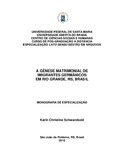| dc.contributor.advisor | Richter, Eneida Izabel Schirmer | |
| dc.creator | Schwarzbold, Karin Christine | |
| dc.date.accessioned | 2014-08-26T14:07:17Z | |
| dc.date.available | 2014-08-26T14:07:17Z | |
| dc.date.issued | 2010-12-07 | |
| dc.date.submitted | 2010 | |
| dc.identifier.uri | http://repositorio.ufsm.br/handle/1/400 | |
| dc.description | Monografia (especialização) - Universidade Federal de Santa Maria, Centro de Ciências Sociais e Humanas, Curso de Especialização de Gestão em Arquivos, EaD, RS, 2010. | por |
| dc.description.abstract | This work aims at identifying the first matrimonial records of German immigrants in the city of Rio Grande and, to perform the paleographic transcription of these records. We analyze the handle and reading conditions of the documents and we try to locate where these ceremonies were carried out in Rio Grande, using the available bibliography and the research in the original records. Using the bibliographic sources available we try to know the reasons for the German immigration to Brazil, to verify how this process happened in the city of Rio Grande – RS and, to understand the wedding ceremony and its historic evolution. The Diocese of Rio Grande is a territorial division of the Roman Apostolic Catholic Church. It was founded in May 27th,1971 by the Pope Paulo VI. The ecclesiastical records are true sources of the past and, they acquire a unique importance because they are the primary sources for researches and, especially in this study, to rescue the German memory in the city. As a result it describes the conservation conditions found at the place where the heap collection is stored, the records reading and the paleographic transcription of the German matrimonial genesis in Rio Grande. It can be found at the reverse of the manuscript Page 12, Book V, the Recording of Marriages at the Parish of São Pedro. The book shows evidences of attack by biological agents like borers and rodents what clearly demonstrates the absence of conservation actions and preventive practices in the collection, making the reading difficult. The first annotation found and actually performed at The Parish of São Pedro was the wedding of Carlos Joze Westendorff with Anna Maria Elisabet. Later in the book we found the wedding annotation of Jorge Fistra with Ignacia Silveira, he being from Bavaria and she was a slaver. The Marriage is earlier (1838) but, it was annotated later because it was not performed in the same Parish of the Records. | eng |
| dc.language | por | por |
| dc.publisher | Universidade Federal de Santa Maria | por |
| dc.rights | Acesso Aberto | por |
| dc.subject | Arquivos eclesiásticos | por |
| dc.subject | Imigração germânica | por |
| dc.subject | Matrimônio | por |
| dc.subject | Paleografia | por |
| dc.subject | Preservação de manuscritos | por |
| dc.subject | Rio Grande | por |
| dc.title | A gênese matrimonial de imigrantes germânicos em Rio Grande, RS, Brasil | por |
| dc.title.alternative | The matrimonial genesis of german immigrants in Rio Grande, RS, Brasil | eng |
| dc.type | Trabalho de Conclusão de Curso de Especialização | por |
| dc.degree.local | Polo de São João do Polêsine, RS, Brasil | por |
| dc.degree.specialization | Gestão em Arquivos, EaD | por |
| dc.description.resumo | Esta monografia apresenta como objetivo geral identificar os primeiros registros de matrimônio de germânicos em Rio Grande, RS, afim de realizar a transcrição paleográfica dos mesmos. Analisa as condições de manuseio e leitura dos assentos e procura localizar onde estas cerimônias foram realizadas no Município através da literatura disponível e da consulta aos registros matrimoniais. Por meio de recursos bibliográficos busca conhecer as causas da imigração germânica e verificar como se deu esse processo no Município bem como compreender a cerimônia de matrimônio e sua evolução histórica. A Diocese de Rio Grande é uma divisão territorial da Igreja Católica Apostólica Romana. Foi criada aos 27 de maio de 1971 pelo Papa Paulo VI. Os registros eclesiásticos adquirem uma importância singular, por serem fontes primárias para o desenvolvimento de pesquisas e, neste trabalho, para o resgate da memória germânica no Município. Como resultado apresenta as condições de conservação encontradas no local de guardo do acervo, da leitura dos registros e a transcrição paleográfica da gênese matrimonial germânica no Município. Esta apresenta evidências de ataque por agentes biológicos, como a broca e roedores sinais claros da falta de conservação e medidas preventivas ao acervo, dificultando a sua leitura. O primeiro assento encontrado, e realizado efetivamente na Paróquia de São Pedro é de Carlos Joze Westendorff e Anna Maria Elisabet. Mais adiante no livro foi encontrado o assento de Jorge Fistra e Ignacia Silveira, ele da Baviera e ela uma escrava. O Matrimônio é anterior (1838), mas o seu registro se deu posteriormente, por não ter sido realizado na Paróquia de origem do livro tombo. | por |
| dc.publisher.unidade | Centro de Ciências Sociais e Humanas | por |


